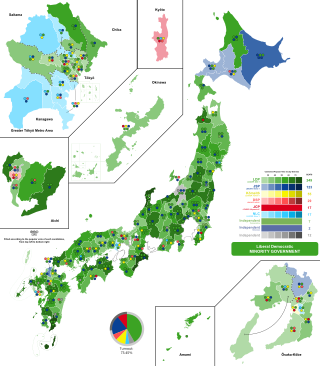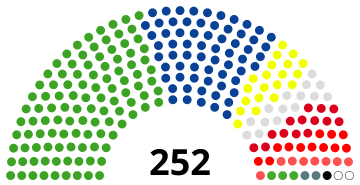
Ryutaro Hashimoto was a Japanese politician who served as the Prime Minister of Japan from 1996 to 1998. He was the leader of one of the largest factions within the ruling LDP through most of the 1990s and remained a powerful back-room player in Japanese politics until scandal forced him to resign his leadership position in 2004. Disgraced, he chose not to stand in the general election of 2005, and effectively retired from politics.

The Social Democratic Party is a political party in Japan that was established in 1996. Since its reformation and name change in 1996, it has advocated pacifism and defined itself as a social-democratic party. It was previously known as the Japan Socialist Party.

The New Frontier Party (NFP) was a big tent political party in Japan founded in December 1994. As a merger of several small parties, the party was ideologically diverse, with its membership ranging from moderate social democrats to liberals and conservatives. The party dissolved in December 1997, with Ichirō Ozawa's faction forming the Liberal Party and other splinters later joining the Democratic Party of Japan in April 1998.

The Japan Socialist Party was a socialist and progressive political party in Japan that existed from 1945 to 1996. The party was founded as the Social Democratic Party of Japan by members of several proletarian parties that existed before World War II, including the Social Mass Party, the Labour-Farmer Party, and the Japan Labour-Farmer Party. The party represented the Japanese left after the war, and was a major opponent of the right-wing Liberal Democratic Party.

General elections were held in Japan on 20 October 1996. A coalition of the Liberal Democratic Party, New Party Sakigake and the Social Democratic Party, led by incumbent Prime Minister Ryutaro Hashimoto of the LDP won the most seats.

General elections were held in Japan on 18 February 1990 to elect the 512 members of the House of Representatives, the lower house of the National Diet.

General elections were held in Japan on 18 July 1993 to elect the 511 members of the House of Representatives. The Liberal Democratic Party (LDP), which had been in power since 1955, lost their majority in the House. An eight-party coalition government was formed and headed by Morihiro Hosokawa, the leader of the Japan New Party (JNP). The election result was profoundly important to Japan's domestic and foreign affairs.

General elections were held in Japan on 5 December 1976. Voter turnout was 73.45%. This election was noted for seeing 124 newcomers win seats for the first time, along with the defeat of some legacy candidates, signalling a generational shift in the Japanese political landscape. To date, the 1976 election has been the only post-war general election triggered by an expiration of the term of the House of Representatives; all other post-war elections have been instigated by a dissolution of the House by the Cabinet.

House of Councillors elections were held in Japan on 8 July 1956, electing half the seats in the House plus two vacant seats in the other half. The Liberal Democratic Party won the most seats, but failed to win a majority. It was the first national election under the 1955 System, approximately a two party system of Ichirō Hatoyama's Liberal Democratic Party (LDP) that was created in the "conservative merger" of 1955 and Suzuki Mosaburō's reunified Japan Socialist Party (JSP). The later dominant LDP failed to win a majority.

House of Councillors elections were held in Japan on 1 July 1962, electing half the seats in the House. The Liberal Democratic Party won the most seats. This was the first Japanese national election to feature the Kōmeitō as a candidate, as it had formed earlier in the same year.

House of Councillors elections were held in Japan on 29 July 2001. They were the first national elections since Junichiro Koizumi became Prime Minister after Yoshiro Mori resigned in April 2001. The Liberal Democratic Party (LDP) and its election allies, were the major winner, provided Koizumi a strong mandates to move forward with his reform policies. The ruling coalition performed well, and regain their majority in the House of Councillors.

House of Councillors elections were held in Japan on 22 June 1980. On 16 May the Japan Socialist Party (JSP) brought no-confidence motion before the Diet relating to corruption issues, proposing more defense spending and rises in public utility charges as reasons for the House of Representatives to withdraw its backing from the government. Unexpectedly, 69 Liberal Democratic Party (LDP) members of the Diet from the Fukuda Takeo, Miki Takeo and Hidenao Nakagawa factions abstained from voting on the motion. The government was defeated by 56 votes in total of 243 and resigned. For the first time elections for both the House of Councillors and the House of Representatives were elected at the same time. In the elections of both the houses the LDP gained a majority.

General elections were held in Japan on 18 December 1983 to elect the 511 members of the House of Representatives. The voter turnout was 67.94%, the lowest it had ever been in post-war history up to that point, and a low which would not be surpassed until ten years later.

House of Councillors elections were held in Japan on 12 July 1998.

House of Councillors elections were held in Japan in 1995.

House of Councillors elections were held in Japan on 10 July 1977. Only half of the House of Councillors was up for election.

House of Councillors elections were held in Japan on 7 July 1974, electing half the seats in the House. The Liberal Democratic Party won the most seats.
The 1994 electoral reform in Japan was a change from the previous single non-transferable vote (SNTV) system of multi-member districts (MMD) to a mixed electoral system of single-member districts (SMD) with plurality voting and a party list system with proportional representation. The reform had three main objectives: change the one-party dominance of the Liberal Democratic Party (LDP) from the previous 1955 system to a two-party system with alternation in power, reduce the cost of elections and campaigns, and change campaign focus from individual-centered to party-centered.

Kagoshima at-large district is a constituency in the House of Councillors of Japan, the upper house of the Diet of Japan. It currently elects two members to the House of Councillors, one per election. It has, historically, similar to other 2-seat, rural prefectures, been an LDP stronghold. The last opposition member elected was before the House of Councilor seat reform, when the JSP successfully elected a candidate in 1995. The closest any party has come to defeating the LDP in the district since was 2007, when Ino Minayoshi lost by only three thousand votes. However, LDP candidates in the district have typically been kept below 50%, mainly due to LDP-infighting; Shuji Maeda took 15% of the vote in the district in 2019, which kept Otsuji below 50%, and in 2022, Ayumi Saigo took a similar amount of the vote, leading to Nomura receiving just under 50% again.

Banchō Seisaku Kenkyūjo was a former faction of the Liberal Democratic Party which formed in 1956 and later merged into the Shikōkai faction in 2017.



















